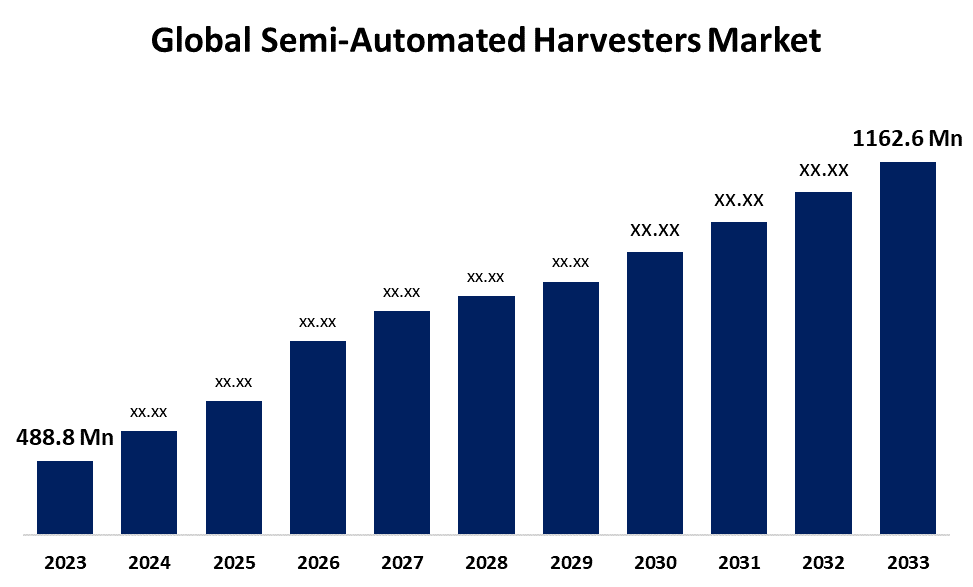Global Semi-Automated Harvesters Market Size, Share, and COVID-19 Impact By Product Type (Combine Harvesters, Forage Harvesters, and Others), By Crop Type (Cereals & Grains, Oilseeds & Pulses, Fruits & Vegetables, and Others), By Application (Agriculture, Horticulture, and Others), By Region (North America, Europe, Asia-Pacific, Latin America, Middle East, and Africa), Analysis and Forecast 2023 - 2033
Industry: AgricultureGlobal Semi-Automated Harvesters Market Insights Forecasts to 2033
- The Global Semi-Automated Harvesters Market Size was Estimated at USD 488.8 Million in 2023
- The Market Size is Expected to Grow at a CAGR of around 9.05% from 2023 to 2033
- The Worldwide Semi-Automated Harvesters Market Size is Expected to Reach USD 1162.6 Million by 2033
- North America is Expected to Grow the fastest during the forecast period.

Get more details on this report -
The Semi-Automated Harvesters Market Size was worth around USD 488.8 Million in 2023 and is predicted to Grow to around USD 1162.6 Million by 2033, with a compound annual growth rate (CAGR) of 9.05% between 2023 and 2033. The market is driven by the growing need for effective agricultural methods and the use of newer technologies like GPS and sensor-based systems in agricultural machinery.
Market Overview
The semi-automated harvesters market refers to industrial equipment that assists in the harvesting process by integrating mechanical operations with some degree of human control or oversight. They generally carry out activities such as cutting, collecting, and threshing crops, but still need a human operator to direct or oversee portions of the process. The market is witnessing high growth as the global population increases, there is a mounting demand for sustainable agriculture solutions that can deliver high productivity with low labor costs, hence fueling the demand for semi-automatic harvesters. Furthermore, the market for semi-automated harvesters is full of opportunities, driven mainly by the growing need for food across the world due to an expanding population. With the demand for effective farming practices gaining momentum, the use of semi-automated harvesters will grow tremendously. Moreover, the movement towards sustainable agriculture provides a special opportunity for manufacturers to create machines that not only improve productivity but also minimize environmental footprints. By emphasizing environmentally friendly technologies and energy-efficient equipment, businesses can enter the expanding market for sustainable agriculture solutions, fulfilling both regulatory standards and customer demand.
Report Coverage
This research report categorizes the semi-automated harvesters market based on various segments and regions, forecasts revenue growth, and analyzes trends in each submarket. The report analyzes the key growth drivers, opportunities, and challenges influencing the semi-automated harvesters Market. Recent market developments and competitive strategies such as expansion, type launch, development, partnership, merger, and acquisition have been included to draw the competitive landscape in the market. The report strategically identifies and profiles the key market players and analyzes their core competencies in each sub-segment of the semi-automated harvesters market.
Semi-Automated Harvesters Market Report Coverage
| Report Coverage | Details |
|---|---|
| Base Year: | 2023 |
| Market Size in 2023 : | USD 488.8 Million |
| Forecast Period: | 2023-2033 |
| Forecast Period CAGR 2023-2033 : | 9.05% |
| 2033 Value Projection: | USD 1162.6 Million |
| Historical Data for: | 2019-2022 |
| No. of Pages: | 220 |
| Tables, Charts & Figures: | 110 |
| Segments covered: | By Product Type, By Crop Type, By Application |
| Companies covered:: | John Deere, CNH Industrial, AGCO Corporation, Kubota Corporation, CLAAS Group, Mahindra & Mahindra Ltd., SAME Deutz-Fahr Group, Yanmar Co., Ltd., Kverneland Group, Iseki & Co., Ltd., Rostselmash, Sampo Rosenlew Ltd., Preet Agro Industries Pvt. Ltd., New Holland Agriculture, and Others. |
| Pitfalls & Challenges: | Covid-19 Empact, Challenges, Growth, Analysis. |
Get more details on this report -
Driving Factors
The semi-automated harvesters market is driven by some major trends. The growing focus on sustainable agriculture. Farmers and agribusiness companies are always looking for ways to maximize yield while saving resources, and semi-automatic harvesters look like a big promise. Such equipment effectively handles harvesting operations that were previously labor-based, hence minimizing the reliance on human labor. Moreover, incorporating technologies like GPS and automation systems ensures precision farming, which maximizes field management and crop yield, further driving the market growth. Furthermore, technological progress also contributes to the market growth of semi-automatic harvesters. The use of sensors and automated systems not only increases the operating efficiency of such machines but also offers precise information about crop conditions and soil fertility. This technologically driven solution helps farmers in making decisions to enhance crop output and quality. In addition, these innovations have also given rise to multi-functional harvesters that can undertake different tasks, which in turn decreases the use of multiple machines and saves costs.
Restraining Factors
The semi-automated harvesters market encounters certain difficulties that would restrain its development. The major restrainers are the high upfront cost of procuring and running these machines. For small- and medium-sized farms, the cost of procuring semi-automatic harvesters is beyond their resources, thus inhibiting market penetration.
Market Segmentation
The semi-automated harvesters market share is classified into product type, crop type and application.
- The combine harvesters segment held the largest share of the market in 2023 and is projected to grow at a substantial CAGR during the forecast period.
Based on product type, the semi-automated harvesters market is segmented into combine harvesters, forage harvesters, and others. Among these, the combine harvesters segment held the largest share of the market in 2023 and is projected to grow at a substantial CAGR during the forecast period. The segmental growth is due to their versatility, allowing simultaneous harvesting, threshing, and cleaning of the grains. Furthermore, the use of combine harvesters is further enhanced by development in automation technology, which makes them more efficient and gives the farmer greater control over the harvest process, thereby increasing yield and minimizing wastage.
- The cereals & grains segment accounted for a significant share in 2023 and is anticipated to grow at a remarkable CAGR during the forecast period.
Based on crop type, the global semi-automated harvesters market is divided into cereals & grains, oilseeds & pulses, fruits & vegetables, and others. Among these, the cereals & grains segment accounted for a significant share in 2023 and is anticipated to grow at a remarkable CAGR during the forecast period. The growth is driven by the worldwide staple demand and the extensive cultivated areas. Moreover, sophisticated features like GPS and automation systems are especially effective in handling large-scale cereal and grain cultivation, guaranteeing accurate operations and reducing losses.
- The agriculture segment accounted for a significant share in 2023 and is anticipated to grow at a remarkable CAGR during the forecast period.
Based on application, the global semi-automated harvesters market is categorized into agriculture, horticulture, and others. Among these, the agriculture segment accounted for a significant share in 2023 and is anticipated to grow at a remarkable CAGR during the forecast period. The segment's growth is attributed mainly to the machines ' improving efficiency and productivity. These machines find extensive use for the harvest of numerous crops, including grains and cereals, oilseeds, and pulses. Additionally, the use of cutting-edge technologies like GPS and automation systems enables precision harvesting, conserving resources, and maximizing the yield on the whole. This is especially important
Regional Segment Analysis of the Semi-Automated Harvesters Market
- North America (U.S., Canada, Mexico)
- Europe (Germany, France, U.K., Italy, Spain, Rest of Europe)
- Asia-Pacific (China, Japan, India, Rest of APAC)
- South America (Brazil and the Rest of South America)
- The Middle East and Africa (UAE, South Africa, Rest of MEA)
Asia-Pacific is anticipated to hold the largest share of the semi-automated harvesters market over the predicted timeframe.

Get more details on this report -
Asia-Pacific is anticipated to hold the largest share of the semi-automated harvesters market over the predicted period. This dominance is due to the large agricultural base and growing use of advanced farming methods. Furthermore, India and China are leaders in this growth, fueled by government efforts to improve agricultural productivity and sustainability. Also, growing labor costs and transitioning towards mechanized agriculture in these nations are also key drivers of the market's growth.
North America is expected to grow rapidly in the semi-automated harvesters market during the forecast period. The market in the region is driven by high degrees of mechanization in agriculture and technological innovations. Moreover, the use of sophisticated technologies like GPS and automation systems is prevalent in this region, necessitating the need for semi-automated harvesters.
Competitive Analysis:
The report offers an appropriate analysis of the key organization markets/companies involved within the semi-automated harvesters market, along with a comparative evaluation primarily based on their type of offering, business overviews, geographic presence, business strategies, segment market share, and SWOT analysis. The report also provides an elaborate analysis focusing on the current news and developments of the companies, which includes type development, innovations, joint ventures, partnerships, mergers & acquisitions, strategic alliances, and others. This allows for the evaluation of the overall competition within the market.
List of Key Companies
- John Deere
- CNH Industrial
- AGCO Corporation
- Kubota Corporation
- CLAAS Group
- Mahindra & Mahindra Ltd.
- SAME Deutz-Fahr Group
- Yanmar Co., Ltd.
- Kverneland Group
- Iseki & Co., Ltd.
- Rostselmash
- Sampo Rosenlew Ltd.
- Preet Agro Industries Pvt. Ltd.
- New Holland Agriculture
- Others
Key Target Audience
- Market Players
- Investors
- End-users
- Government Authorities
- Consulting And Research Firm
- Venture capitalists
- Value-Added Resellers (VARs)
Recent Development
- In April 2025, the semi-automated system created by Isro's National Remote Sensing Centre (NRSC) launched near real-time tracking of sowing and harvesting of crops in the ongoing Rabi season in India.
Market Segment
This study forecasts revenue at the global, regional, and country levels from 2023 to 2033. Spherical Insights has segmented the semi-automated harvesters market based on the below-mentioned:
Global Semi-automated Harvesters Market, By Product Type
- Combine Harvesters
- Forage Harvesters
- Others
Global Semi-automated Harvesters Market, By Crop Types
- Cereals & Grains
- Oilseeds & Pulses
- Fruits & Vegetables
- Others
Global Semi-automated Harvesters Market, By Application
- Agriculture
- Horticulture
- Others
Global Semi-automated Harvesters Market, By Regional Analysis
- North America
- US
- Canada
- Mexico
- Europe
- Germany
- UK
- France
- Italy
- Spain
- Russia
- Rest of Europe
- Asia Pacific
- China
- Japan
- India
- South Korea
- Australia
- Rest of Asia Pacific
- South America
- Brazil
- Argentina
- Rest of South America
- Middle East & Africa
- UAE
- Saudi Arabia
- Qatar
- South Africa
Frequently Asked Questions (FAQ)
-
1. What is the CAGR of the semi-automated harvesters market over the forecast period?The global semi-automated harvesters market is projected to expand at a CAGR of 9.05% during the forecast period.
-
2. What is the market size of the semi-automated harvesters market?The global semi-automated harvesters market size is expected to grow from USD 488.8 Million in 2023 to USD 1162.6 Million by 2033, at a CAGR of 9.05% during the forecast period 2023-2033.
Need help to buy this report?